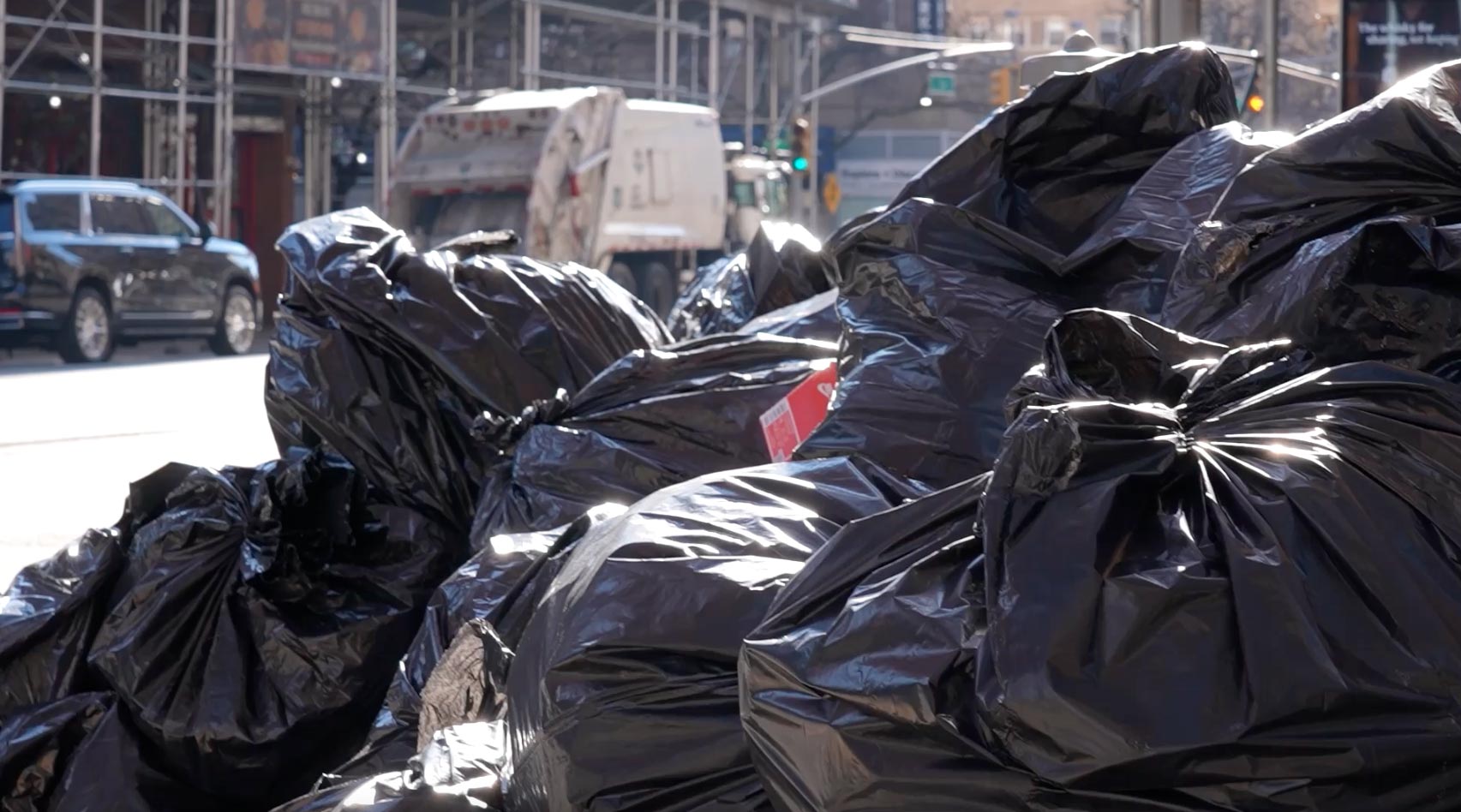
Bin It, to Win It: NYC vs. Rats
A new containerization law in NYC is helping reduce trash and rat sightings, while "rat tourism" shines a light on the city's ongoing battle with its rodent problem.
By Sophia Francesca Stern
In the bustling streets of New York City, where the skyline is as famous as the food and culture, there is one attraction that may surprise both seasoned tourists and long-time residents: rats.
New York City’s nocturnal dwellers have become an unexpected source of interest for many visitors. What began as a viral TikTok live has evolved into an unusual niche phenomenon: rat tourism.
Kenny Bollwerk, a social media manager turned rat tour guide, is at the forefront of this movement. He has transformed his interest in the city’s rodent problem into an instructive and entertaining experience for hundreds of visitors and social media users not only in New York but around the world.
It began as a curiosity, quickly evolved into an official business, and is now prompting a bigger discussion over how to coexist with city rats and what else has to be done to solve the problem at its root.
“It was one night where I kind of stumbled upon the rats, not knowing that it would kind of lead to this rat tourism thing, and this kind of, like this whole fascination with rats, like this entertainment factor, but also a way of, kind of combating and trying to control the rat population as well,” said Bollwerk.
Rat tourism, though a small but growing movement, offers guests the chance to observe New York City’s rodent population up close. Bollwerks tours take people through neighborhoods that have high levels of rat activity, such as Harlem and Queens, where rats thrive due to the city’s dense infrastructure and abundant food sources.
Bollwerks Tours has drawn a varied range of customers, from locals who have lived in the city for years to international tourists looking to cross rat spotting off their NYC travel bucket list.
“I think rats look pretty cool. I come from a place of no rats, so seeing rats is very cool; when I see them, I get reminded of TV rats, how everyone thinks they are so gross, but I feel they are funny-looking, chill guys who I can hang out with.” said Devaughn Sylvester, a tourist from Shiprock, New Mexico.
Bollwerk has held live streaming and in-person tours for people from around the world, from Europe to the various boroughs of New York City. The tours are conducted at night, around 10 pm or later, when the rats are the most active. It’s a one-of-a-kind pastime that has piqued interest and a desire to view these rodents up close.
“I’ve had so many different opportunities to meet different people around the world I would never have met just because of rats. So, rats really bring people together.” said Bollwerk.
However, the fascination extends beyond the rats themselves. Bollwerks Tours also seeks to educate and raise awareness about the continuous effort to reduce rat populations, urban sustainability, and waste management. This mirrors a broader trend of people interested in exploring some of New York City’s less prominent and sometimes overlooked neighborhoods.
“I know some people think they’re so cute. They are cute, in a way. But they’re an invasive species. They don’t belong here,” said Joshua Goodman, the Deputy Commission of the NYC Department of Sanitation
For many people, rats are just part of the urban landscape, blending in. These rodents have adapted to living with people so well that they may go unnoticed by residents who have become accustomed to their presence. In some ways, rats are considered a natural result of urban existence, and their presence, while somewhat nasty, is seen as an unavoidable issue.
However, others, such as Goodman, see the rats as a continuing problem that must be tackled rather than ignored. It concerns both the environment and public health. The ongoing problem of rat infestations has become a cause of frustration for many city residents, particularly in regions that receive little attention and may be neglected.
“You want to improve everyone’s quality of life, no matter where they live. If there’s a rat situation or a rat problem in your neighborhood, it should be addressed first before some other neighborhood. Everybody should have some kind of equity when it comes to making sure that the rats are not going to be a part of their everyday life,” said Bollwerk
Bollwerk’s visits have allowed him to document and manage massive rat infestations, helping to resolve the matter. If he detects a huge infestation, he will remain in the area until the infestation is resolved and the rats have been removed.
“So we’ve successfully been to 10 different locations around our city, and each of those locations in the two years successfully making change, whether it’s removing a dining structure or shutting down a restaurant,” said Bollwerk
Rats have been a part of New York City’s urban landscape since the early settlers, most likely arriving with the first ships from Europe. Their populations have grown dramatically over time, owing to the city’s fast urbanization, high population, and massive waste output, making it a perfect breeding site for rats. With more than 3 million rats estimated to live in the city as of 2023, the issue continues to be a major focus for city officials.
“We put out 44 million pounds of trash daily at the curb. That’s Radford. It’s what we call the all-night, all-you-can-eat buffet for rats. When we set it out in these black bags that they just rip right into,” said Goodman
The rat population has caused frustration among city officials, companies, and individuals alike. Mayor Eric Adams has made rat mitigation a top concern, attempting to reduce the growing rat population and issues. Every year, the city spends millions of dollars on rat mitigation, which includes pest control programs and attempts to reduce food waste in public spaces.
The city has increased measures to regulate waste on the streets. A recent residential waste containerization law, as of November 12, requires properties with 1–9 units to use city bins with secure lids. This reduces black trash bags on the street, eliminating the food buffet for rats.
“We have up to 70% of the city now required to containerized waste. So, each piece contributes more and more to getting all of our waste. Containerized, cutting off all rats. Rats. Access to all food across our city,” said Kathleen Corradi, or rat Czar, the city’s first city-wide director for rat mitigation.
Bollwerk’s tours, which typically last about one hour and cost $40 per person, are interactive and designed to educate guests on these ongoing concerns and how they can contribute to mitigating the rat problem in their own neighborhoods and the city’s rat mitigation efforts.
“It’s like a triangle that they have: food, water, and shelter. If you take those things away from them, they’re not going to be able to live. So make sure that you try to take those things away as much as possible,” said Bollwerk.
Bollwerk’s tours contribute to tackling wider urban concerns by engaging people in conversation, educating them on the subject, and providing a tourist experience.
“The trash bins are a key tool in this work in their ability to cut off rat access to food. However, that’s when done correctly. And that’s why the education is so important,” said Corradi
While rat tourism is popular in New York City mainly, different versions of rat tours can be found in Chicago and Cambodia, each offering distinct experiences and excursions.
Chicago will transport you beneath the city into the underground networks of tunnels and subways where rats are known to live and roam. At the same time, Cambodia offers rat tours on a very different but equally fascinating dimension. Here, visitors can observe and learn how the APOPO foundation trains rats to detect landmines and unexploded ordnance.
While the concept of paying to view rats may appear strange, it relates to a larger issue of urban exploration. In a world where people are becoming increasingly fascinated about particular topics, rat tourism provides a unique perspective, allowing them to study aspects of urban life that they may or may not have been exposed to.
“To me, it’s just a fun experience to meet new people, but also to walk around the city and enjoy your sightseeing. Because it’s not only the rats that you are also going to see at two in the morning when you’re walking around on a rat tour. You never know what you’re going to see.” said Bollwerk.
As New York continues to deal with the rat problem, rat tourism continues to be a unique but effective method of raising awareness and teaching people how they can help with the rat problem. Whether viewed as adorable, invasive, or somewhere in between, these rats have become an undeniable part of New York City’s personality, leaving their imprint on a city that never stops growing and evolving.
Bin There, Done That: NYC’s Trash Revolution
By Elena Xiang
Virginia Ghazarian lives in a three-unit building in the East Village. For decades, she had grown accustomed to seeing rats scurry out of the garbage bags in her front yard. But things have changed drastically since last month.
Starting Nov. 12, all properties with one to nine residential units are required to use bins of 55 gallons or less, equipped with secure lids, for trash disposal. Although residents can use their own bins that meet the requirements for now, they must switch to the official NYC Bin by June 2026.
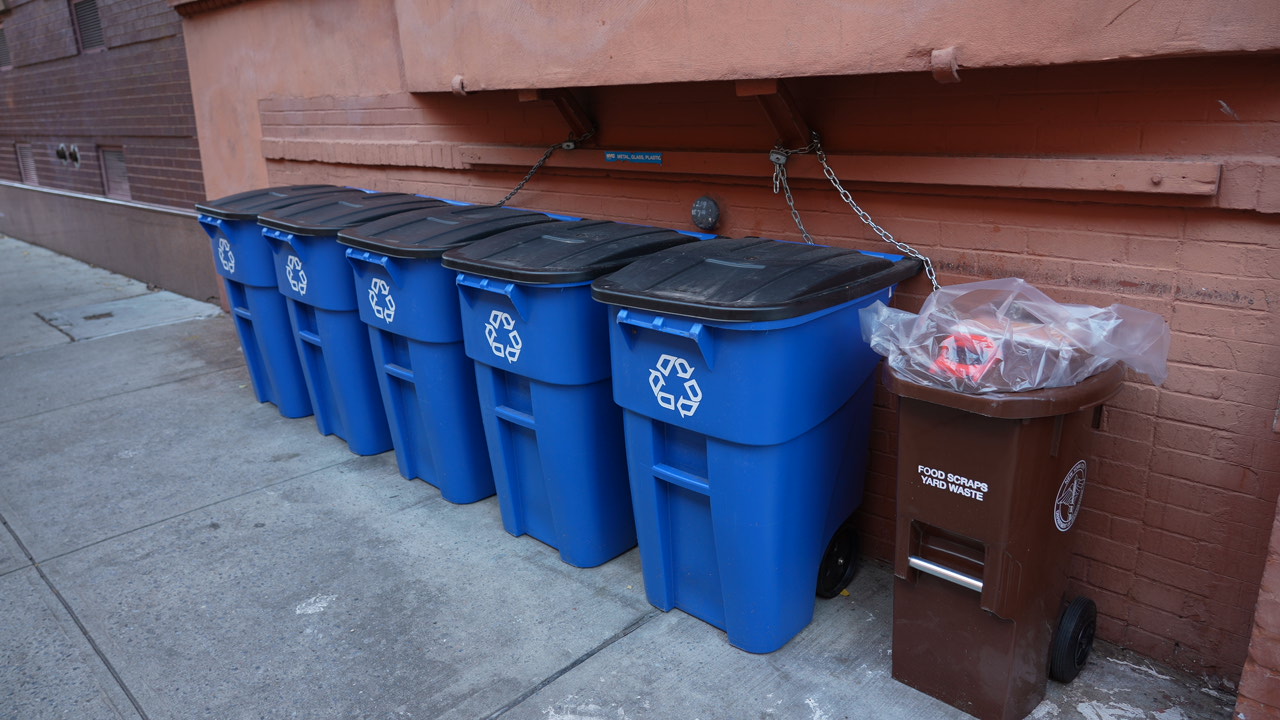
The official NYC Bins. Photo by Elena Xiang.
The policy aims to reduce the rat population by containing one of their primary food sources. It applies to approximately 765,000 buildings across the five boroughs, covering about 98% of all residential properties in New York City.
While the remaining 2% of larger buildings are currently exempt from containerization requirements, experiments for garbage containerization in large buildings were conducted in West Harlem this September.
These pilot programs were declared successful a month later. Consequently, citywide implementation is set to begin in 2025. Buildings with 31 or more units will be required to use stationary on-street containers for trash, serviced by new automated garbage trucks.
Harvey Epstein, a New York State Assembly member representing the 74th District in Manhattan, is a strong advocate for containerization in larger buildings.
“I am really pushing for it,” Epstein said. “My building is large, so we’re not currently required to do it under the law. But I still think it’s necessary. We need everyone to containerize as soon as possible.”
Meanwhile, progress is already underway for smaller buildings under the city’s new policy.
“This is the first residential container requirement in 50 years,” said Joshua Goodman, deputy commissioner for public affairs at the Department of Sanitation. “About 450,000 bins have been purchased so far, from all over the city, and orders are increasing every day.”
For the past 50 years, New Yorkers have been discarding garbage in plastic bags directly on the street, a practice that began in 1968.
During the sanitation workers’ strike in 1968, piles of garbage overflowed and remained uncollected around metal bins. Then, when the chemical industry donated 200,000 plastic trash bags to the city, residents quickly discovered their benefits—they were light, neat, and easy to collect.
Professor Steven Cohen of Columbia University, an expert in sustainability policy and public affairs, highlights this chapter in the city’s history when it transitioned from metal bins to plastic bags.
“Before 1968, New Yorkers threw their garbage into metal cans, and sanitation workers would come to empty the contents into the truck,” Cohen explained. “Plastic bags are much lighter to pick up and toss into the garbage truck. Building workers liked them, too, because they didn’t have to wash out the metal cans. But what people didn’t realize was that all the food waste in the plastic bags became a buffet for the rats.”
While cities like Paris have been containerizing garbage since 1884, New York has fallen far behind in this trash revolution.
Mark, who declined to provide his last name for professional reasons, is from Ireland, where containerization is a common practice. Since moving to New York, he has never gotten used to seeing mountains of trash bags piled on the streets.
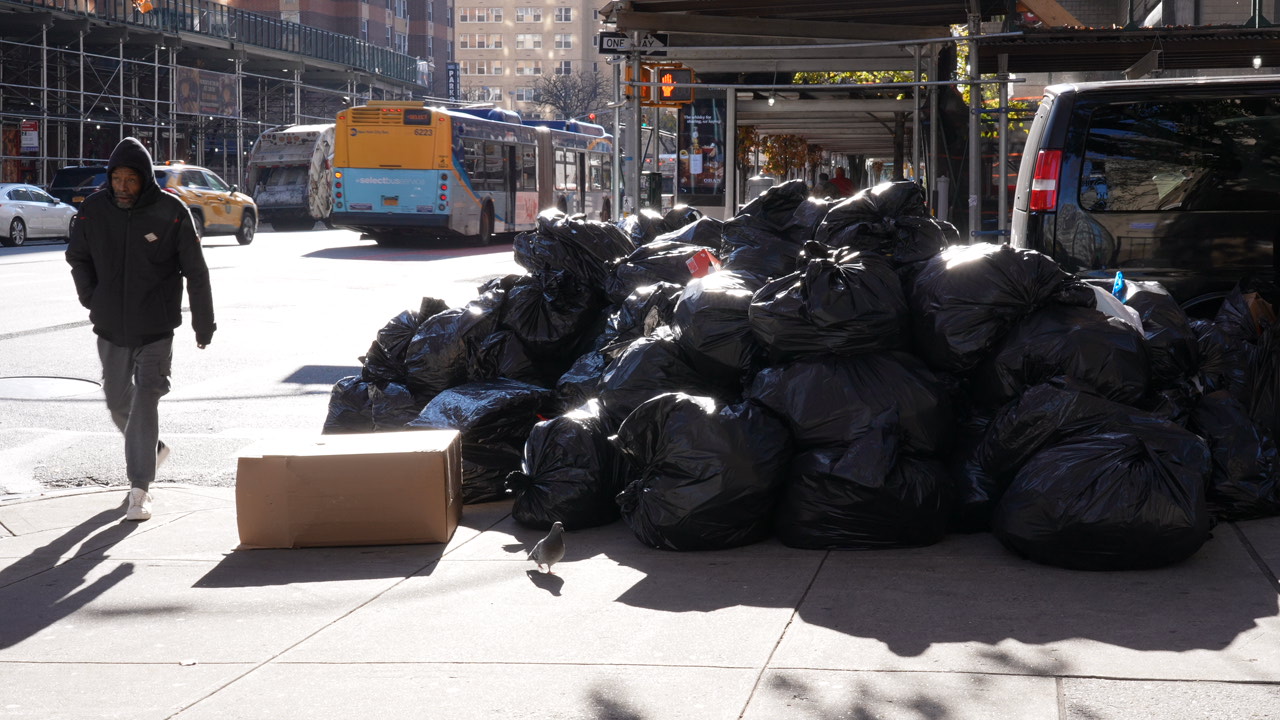
Mountains of trash bags in NYC. Photo by Elena Xiang.
“I used to keep the garbage in our unit and put the bags out every Thursday. Because we had a really bad rat problem in this neighborhood (East Village), I always used double bags to make it harder for the rats to tear them open. But I don’t think others were doing the same,” he said. “I think it’s time for a change.”
Mark’s building purchased two bins after the policy was issued, but one has already been stolen. A similar incident happened to Eva Dorsey, who runs a children’s and maternity consignment store just a few blocks from Mark’s apartment.
“We’ve already had one new recycling bin stolen,” Dorsey said. “The cost of replacing falls on the co-op building, as it’s supposed to be covered by the maintenance fees we’ve already paid.”
However, for individual property owners, the responsibility for preventing theft and covering the cost of a lost bin falls solely on them. On the street, many bins outside apartment buildings are chained together or secured to other structures, such as utility poles or railings. Some bin owners mark their bins with their apartment numbers to make them less likely to be stolen.
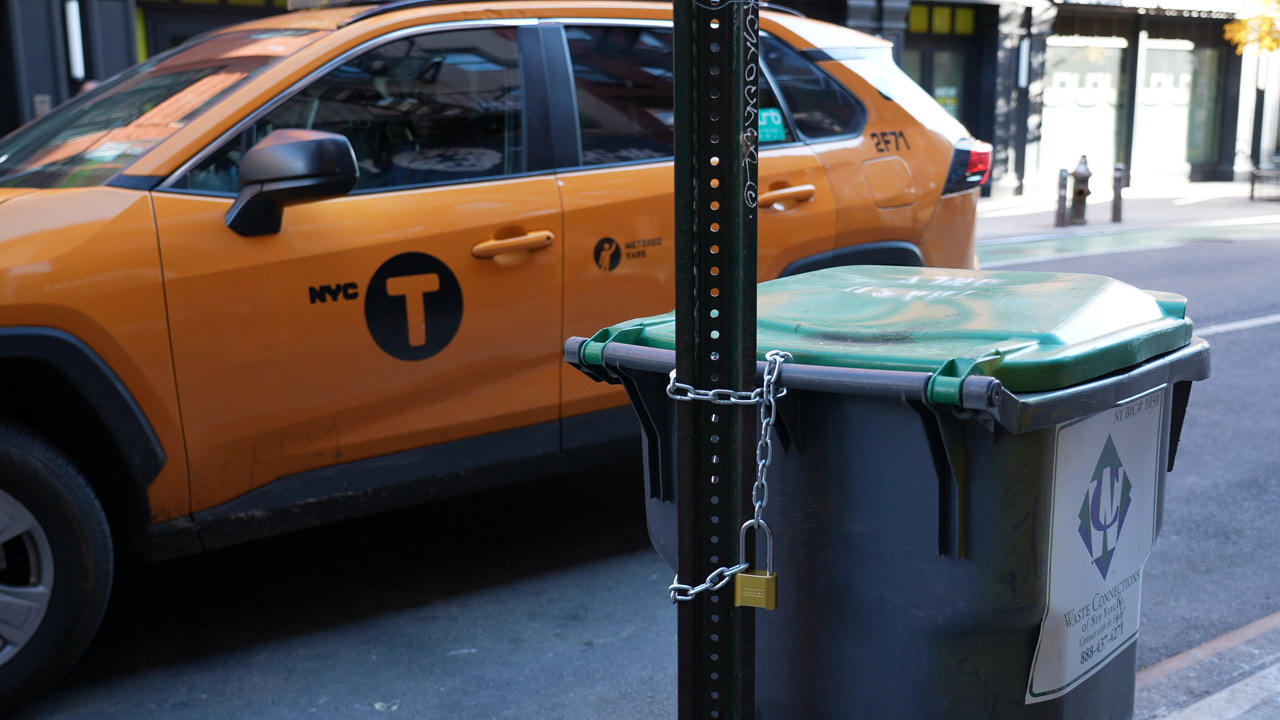
A bin chained on a utility pole. Photo by Elena Xiang.
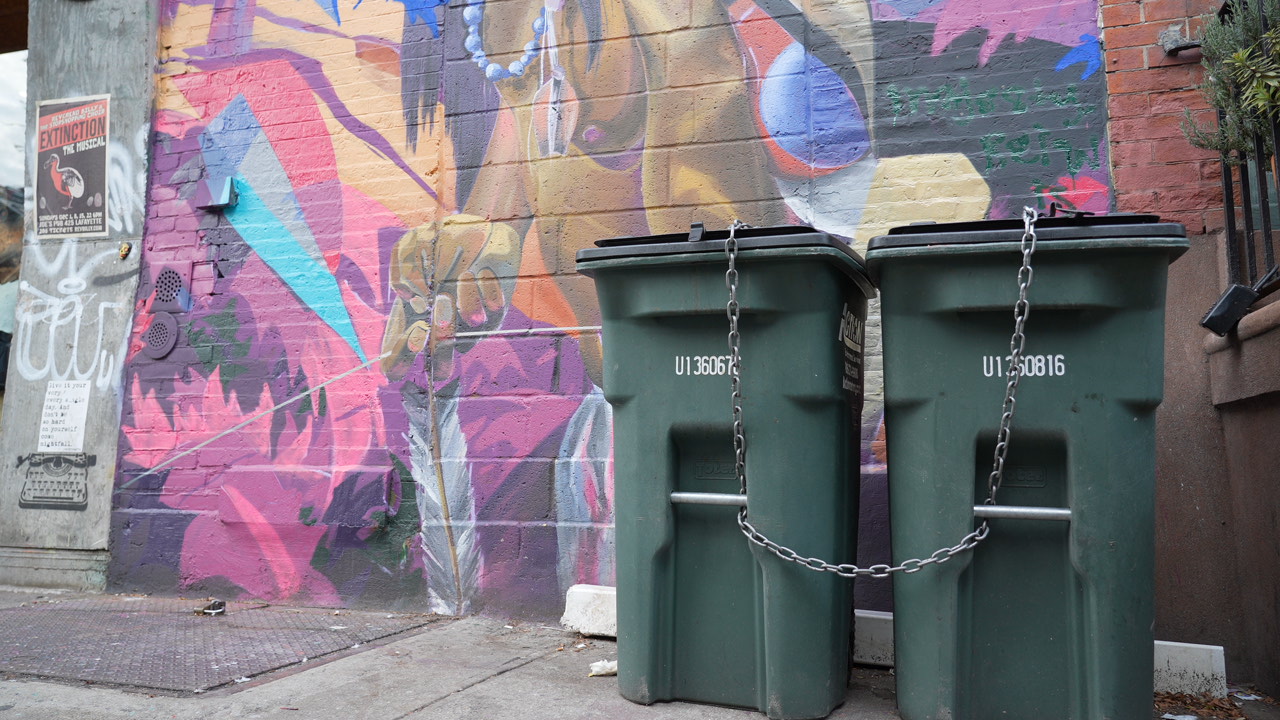
Bins chained up together on the street. Photo by Elena Xiang.
The official NYC Bin has a 10-year warranty, but theft is excluded from the coverage. This means that if a theft occurs, the individual property owner must immediately pay $53.01 to get another 45-gallon trash bin.
“They want us to buy new cans. What happened to all these old cans?” asked Jose Olivo, a super who manages two buildings in the East Village. “The money we spent on containers—so now we’re gonna spend new money on new containers.”
“And then you have lots of people that come around and take the containers, even if you chain them up. And if you chain them up, the sanitation workers don’t want to take the bags out—they want to take the whole container to the truck. It’s hard whichever way you look at it.”
While citizens’ concerns have grown, Goodman emphasizes that the challenges are manageable.
“I understand that there’s growing pains, but we don’t think it’s going to be a long-term problem,” said Goodman. “The bins are designed with a few anti-theft elements. There’s a big white space on one side to write your address to make it clear whose bin it is. They have a serial number, and they all have an RFID tag. It’s not a tracker—we cannot find your missing bin—but if we find the bin down the block, we can use that to know who it belongs to and take it back.”
The problem of bin theft varies by neighborhood. In Park Slope, Brooklyn—another neighborhood heavily affected by the policy because it has numerous brownstone buildings—fewer people secure their bins with chains.
For residents of Park Slope, figuring out how to address the rat problem beyond the containerization policy is a major concern.
Emily Wong, a lifelong resident of Park Slope, purchased the official NYC Bin the moment she saw the information in the local newsletter. However, Wong thinks containerization is just the very first step.
“People have to be more aware of what rats eat,” Wong said while cleaning the leaves in her yard. “A lot of the neighbors have dogs, but the dog poop isn’t being picked up. They cover it with the leaves and think people won’t notice it. There are also pumpkins on the ground from Halloween. Rats eat those things.”
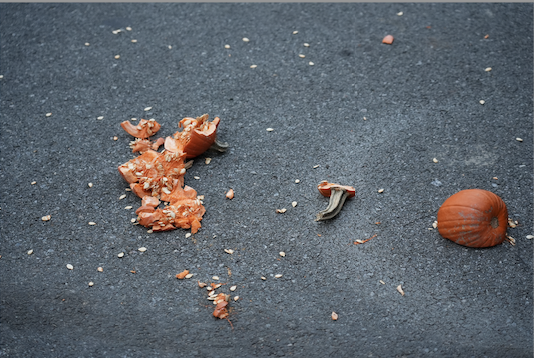
Pumpkins on the ground. Photo by Elena Xiang.
Wong’s neighbor Eli, who declined to give his last name for privacy reasons, has dealt with severe rat issues in his building. Earlier this summer, Eli was forced to hire a rodent control team to clean up. He believes containerization is a good start and a more sustainable solution compared to poisoning rats.
Eli is referring to a pilot program that was approved this September. The initiatives will use ContraPest, a type of rodent birth control, to address the growing rat population.
“I think poisoning rats is not the solution,” Eli said. “It has terrible ecological effects. It’s really harmful to other animals, like vultures, because poisoned rats will eventually be eaten by them. It can also impact humans.”
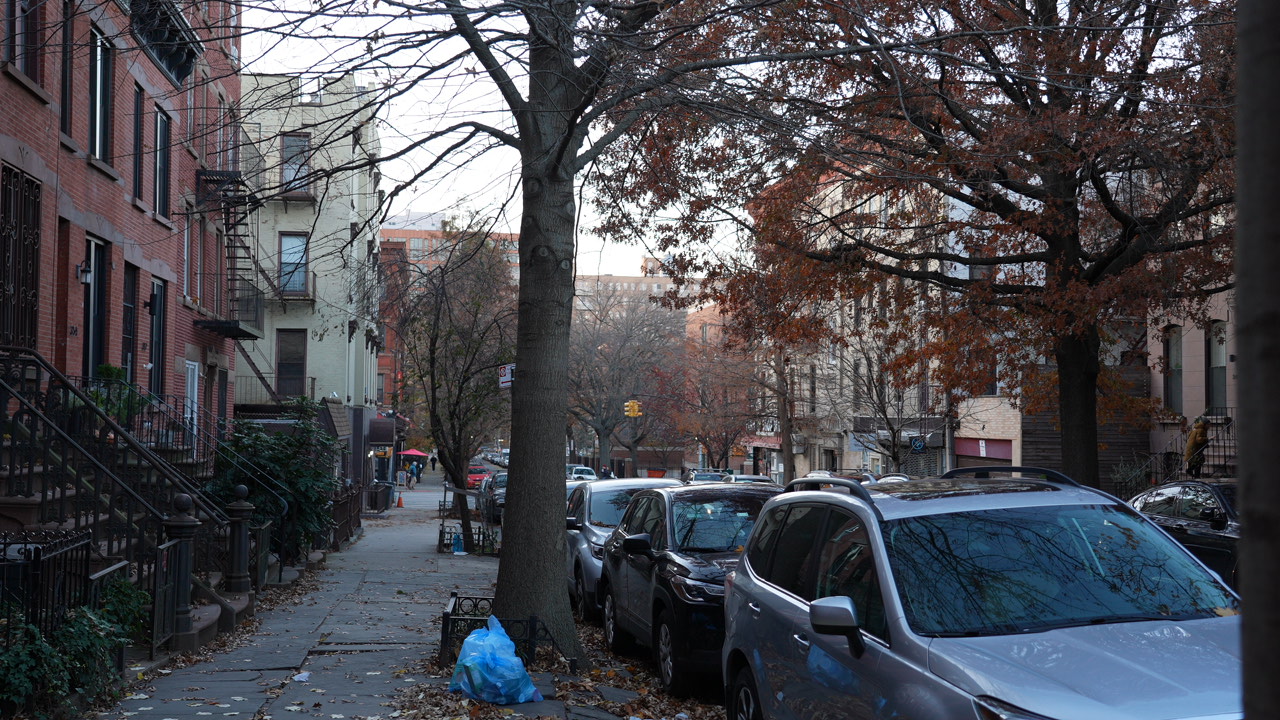
Brownstone buildings in Park Slope, Brooklyn. Photo by Elena Xiang.
While each neighborhood faces its own challenges, a shared concern is the policy’s enforcement. As with many other sanitation practices, the success of this policy largely depends on citizens’ awareness and self-regulation.
Currently, locals are in a grace period between the policy’s issuance and the beginning of official warnings. Beginning Jan. 2, 2025, authorities will start fining buildings that fail to comply with bin requirements.
Fines will be $50 for the first offense, $100 for the second, and $200 for the third and all subsequent offenses. Warnings will be posted on the door of the violating address and directed to the property owner.
Troubled by rats for decades, Ghazarian was quick to purchase the new bins, hoping the policy would finally bring relief. However, she noticed that her neighbors never put out their own trash. Instead, they leave it in front of larger buildings, as those with 10 or more units can still use plastic bags.
“They’ve been flying under the radar, and it’s unfair to those of us following the rules,” she said.
Test Side
By Stine Agnholt Andersen
She walks towards one of two large windows in the living room, each of them with a windowsill big enough to fit both a plant, a dog bed, a decorative gold bowl and a talkative resident.
Kristine Berube used to spend hours during the week talking to neighbors and following life on 148th Street in Hamilton Heights. Now, the window is covered with a big curtain, leaving no space for neither dog nor window-small talks.
“These windows have always been the portal of this tiny space. But now, since the dumpster pilot program, I have to keep them covered up,” says Berube, a 67-year-old former artist and vocal critic of a yearlong containerization project in West Harlem.
For 23 years, she has called the two-bedroom apartment in Hamilton Heights home, and the windows were, until September 2023, her favorite part. Then came the containers. Now she’s not even sure, she will be staying in the apartment.
“If I knew there were going to be four dumpsters outside my window of course, I would have protested before. I mean, at least they could have been more tactical in placement,” says Berube.
Earlier this month, when she spoke with me, she was wearing paint-splattered overalls, trying out a new wall color in the living room to see if that will make her feel more at home.
In other big cities around the world, containers have played an important role in trash handling for years. But in New York, it’s a different story. Here, much of the 44 million pounds of waste produced every day, is left for pick up in the curbs, making it an easy target for hungry rats.
But times are changing.
In 2022 the Adams administration launched what they called “the Trash Revolution” to get rid of rats as well plastic bags on the streets. The first step was to change times for set out to reduce the number of hours that the trash sits in the streets. Next came a study of containerization models in New York City, and in fall 2023 a million-dollar pilot program for the containerization of big buildings was introduced in 10 selected blocks of Hamilton Heights. One of them is where Kristine Berube happens to live.
The area previously had one of the highest amounts of rat sightings in New York City, but for the past year shared wheeled bins on the street have replaced trash bags in the curbs, and trash collection has increased to six days a week as a part of the program. The containers have led to a 60 percent decrease in rat sightings, from 111 in September 2023 to 45 at the same time this year. But it has also left frustrated neighbors and stakeholders behind, locals who feel overrun by the Sanitation Department, the agency in charge of the program.
“In a project that is very specifically geared toward a local community, it’s really important to actually understand what the community’s biggest needs are,” says Daniel Neill, a professor of public service and urban analytics at the Wagner School of Public Service, atNew York University.
“In fact, the projects did quite well at achieving its intended consequences. At the same time, we saw notable unintended side effects that, and some of them could have been relatively easily fixed, if there was a way of making sure that the residents’ concerns were heard,” Neill says.

Overflown containers on 147th Street. Photo: Andre Martin
Unwanted residents
Walking down 147th Street between Amsterdam and Broadway, it is hard not to notice the new box plastic residents of Hamilton Heights. The containers are installed on the street typically in pairs of two, three or four depending on the size of buildings they are serving. A couple of the containers are so full that the lids are open, revealing that the big black plastic bags are indeed still here, but now inside containers.
“The Sanitation Department came to us two summers ago, and said they were going to institute this new program about garbage collection. And we would be a part of the process, selecting the streets, having input. But that didn’t happen,” says Victor Edwards, chairperson of Manhattan’s Community Board 9. He learned about the actual implementation of the project when residents started calling him.
“They got letters saying that this program would start the following week with no information for us. So, we were quite taken aback by that, you know, lack of transparency,” Edwards says.
Before the pilot was initiated, each building was responsible for its own trash. At certain times during the week, building supers would take out the trash to the streets and make sure that waste was sorted and recycled, if necessary.
“Now, we don’t have any jurisdiction or control over these bins. And still, they are here in front of our building,” says Andre Martin, a Hamilton Height resident of 35 years, while pointing at four big wheeled containers on the street right in front of his building. He calls himself rats’ worst enemy, as he used to be responsible for trash handling in his building.
Now that responsibility is shared between all the neighbors on the block, and everyone can use the four containers outside his house, including local shop owners, who otherwise must pay for waste management service. A combination, Martin says, that has led to overflowing containers and garbage on the streets.
“Why did the department want these ones? I understand it was an experimental thing, because they got a lot of complaints about rats. But they just put these out and never followed up with any sort of strategy,” Martin says, scrolling through picture after picture on his iPhone of overflown containers.
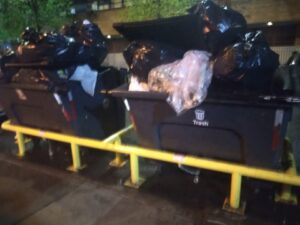
Overflown containers on 147th Street. Photo: Andre Martin
And then, there is the parking problem.
“It takes up 5 to 8 parking spaces per block, which is a lot,” says Edwards, and walk towards a part of 147th Street where triple-sided parking has now emerged, leaving only a single lane for vehicles to pass through.
“This is bad. A fire truck couldn’t get through,” he says, looking resignedly at the rows of cars clogging the street.
The lack of parking spaces is, according to Edwards, especially a problem for the residents who work far from home and either don’t feel safe using the subway in the evening hours or can’t, because Hamilton Heights lacks elevators at its stations.
“I just want communication. If we see something, we should be able to communicate with the Department and see changes or at least discuss it. A balanced approach, not just go right ahead without consulting us,” Edwards says.
The frustrations of neighbors and community leaders like Edwards highlights the importance of early and consistent community involvement in projects like the pilot program in Hamilton Heights.
“If they had spent a bit more time communicating with the residents, who would be affected by their project, they would have been able to get them excited about the potential benefits of the project, understood their very relevant concerns and mitigated those unintended side effects,” says Professor Neill.
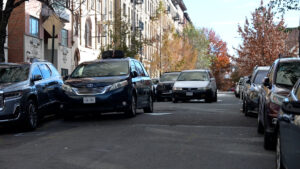
Double-parking on 147th Street between Broadway and Amsterdam.
Clare Miflin agrees.
She is an architect and founder of ThinkWoven and the Center for Zero Waste Design that for years have worked to develop design strategies to reduce and better manage waste, including collecting waste in containers.
“I know for it to be a success, you have to think the project through. I said they should really educate and engage the residents and building staff and give them plenty of support. If you don’t support them, they’re not set up for success,” she says.
Miflin has been actively involved in efforts to improve waste management in New York City since 2017, and after learning about the pilot program in West Harlem, she reached out to DSNY and raised her concerns about the implementation of it. Especially the importance of engaging the community.
“I told them that I don’t think this pilot makes any sense. Dumpsters in the street are so ugly, the lids don’t fit properly and people are going to think that it is a permanent idea. They aren’t going to want these in front of their houses. But they didn’t listen. They did anyway,” she says.
In the two-bedroom apartment at 148th Street, Kristine Berube, feels anything but included in the process surrounding the four containers that, for more than a year, have been placed outside of her window. On the dining table, she has gathered correspondence, emails, and photos of overflown containers that she has sent to authorities over the past year. Berube has tried to raise her concerns, but the containers remain in place.
But if the goal is to tackle the rat problem, the containers must be placed somewhere. I ask her, if it isn’t just bad luck, that they ended up in front of her doorstep?
“No, it’s not bad luck. What’s bad luck is this concept that we could all share the dumpsters, so that nobody is accountable. Two doors down, they don’t have to care what the bins look like. They don’t care about my building, my view or quality of life,” Berube says.
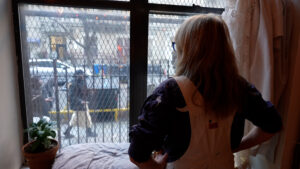
Kristine Berube looking out here window on 148th Street.
In the Sanitation Department’s Manhattan office is Deputy Commissioner, Joshua Goodman, and he admits that the pilot program has issues: missing locks and the status as shared being the main ones.
“We’ve seen very positive results from this program, but we’ve learned that the model we’re using on these ten blocks cannot be the one that expands citywide,” Goodman says.
By Spring 2025, the wheeled containers will be replaced by new stationary, not-shared ones in front of large buildings with 31 units or more. Smaller buildings can request the stationary containers, also known as Empire Bins, or use wheelie bins. The containers will be locked, for use only by the staff of the building in charge.
The goal is to make district M9, covering Hamilton Heights, Manhattanville and Morningside Heights, the first area in New York City, where all trash is off the street and in containers.
When it comes to community involvement, Goodman says, that the public was noticed prior to the implementation of the pilot program either by mail or door knocking. In the next face of the project, DSNY will continue this effort.
“We are going to knock on every single door and send every single resident two letters,” Goodman says and adds that he a couple of months into the pilot program started attending community board meetings as well.
“I always ask the same question: Were any of us consulted about the black bags of trash on the street? I sure wasn’t. We were forced to accept that. And now, we are making a change for the better, together,” he says.
Back on 147th Street, Edwards acknowledges that positive changes have been made regarding communication with the Sanitation Department over the past few months.
“They come to our meetings monthly now so we can give them feedback, which they weren’t doing in the beginning. So that’s a positive sign. We’re just hoping that as they move forward, they’ll listen a little more to us, and we can gather feedback from the buildings”
Rubbish Rules
Supers across New York City are fighting new rule changes from DSNY
By Will Fitzpatrick
Dominick Romeo, a third-generation superintendent from Hell’s Kitchen, manages just one 60-unit building in Chelsea these days. The rest of his time is occupied by his campaign to run for City Council next year in New York City’s District 3.
Romeo is no stranger to local politics—he’s been heavily involved in protests and activism since he was young and has taken up prominent roles in the Black Lives Matter and ACT UP movements. “If you’re not losing your voice in a protest, you’re doing something wrong,” he said. But it wasn’t until recent rule changes by the Department of Sanitation that finally convinced Romeo to enter the political ring himself.
“They do not care about their citizens anymore. That’s why we’re mad. They don’t give a damn about us anymore.”
Back in October of 2022, Mayor Eric Adams and Sanitation Commissioner Jessica Tisch kicked off New York City’s “trash revolution,” a series of new laws aimed to “rethink of the relationship between 8.3 million New Yorkers and 14 billion annual pounds of trash.” New policies included required containerization for private buildings, a revamped composting program, and – what ultimately convinced Romeo to run for public office—the change in set-out times for trash from 4 p.m. to 8 p.m.
The Department of Sanitation argues that these changes will improve quality of life for New Yorkers while also curbing rat and pest infestations by reducing the time the trash is spent sitting on the sidewalk. Romeo, however, feels these changes have done nothing but “devastate our lives.”
Superintendents are a backbone of New York City. Not only do they manage nearly all of the private residential buildings around the city, but they are also an integral cog in the New York City waste process; they are charged with managing, sorting, and setting out the nearly 24 million pounds of residential waste produced every day across the five boroughs.
By changing the set-out time from 4 p.m. to 8 p.m., many supers have had to extend their hours outside of their old nine to five schedules, needing to work almost twelve hours on trash pickup days.
“Now we have to get off at five and come back at eight,” Romeo said. “That means no dinners with our families and friends, no after school events with our children. Every other holiday or event we have to miss. I had tickets to go see several plays, several musicals, and the answer’s always no, no, no, I have to throw out garbage at eight.”

Dominick Romeo takes out the trash late on a Friday night
Department of Sanitation spokesperson Vincent Gragnani said that building managers and supers also have the opportunity to put out trash between 4 a.m. and 7 a.m., offering a “flexible option for building superintendents who work earlier shifts.” Romeo, however, thinks waking up earlier is just as unreasonable as the 8 p.m. set out time.
“I don’t know what gave the city the right to manage our hours. If we were to go to the 4 a.m. time, we’d have to wake up at 3 a.m.,” Romeo said. “We still have an eight to five job to do.”
In response to these changes, Romeo started NYC Building Supers, a grassroots organization trying to convince the Department of Sanitation to move the set-out back to 6 p.m. He has organized protests in front of City Hall, demanded meetings with councilmembers and members of the Department of Sanitation, and convinced other superintendents around the city to join his cause. As many superintendents around the city are often immigrants or undocumented, Romeo feels an obligation to speak up for those who are too nervous to speak up themselves.
One of those supers is Jesmond Portelli, an immigrant from Malta who came to New York City 24 years ago. Despite being nervous about losing his job, the recent rule changes from the Department of Sanitation have disrupted his life so severely that he cannot help but speak out.
“I’m a single father, right? So, I have to do my things, I have to clean, I have to cook, I have to see what my son did in school. And in the morning, I have to make sure he’s up, ready to go. It’s a nightmare, they ruined our lives.”
Portelli has also been worried about the increases in trash related ticketing for those who have spoken up. He claims that the Sanitation Department has put a target on his buildings.
“A couple of weeks ago, I got three tickets in one hour because I took [the trash out] early. Three tickets from one inspector.”
He often compares the situation in New York City to that in his home country of Malta, noting that education around sanitation issues is much more pervasive than in New York and around the United States.
“Everything is organized. Everybody is doing his part, but it’s on TV every day what do to with your trash,” Portelli said
Part of Romeo’s and NYC Building Supers’ proposals for City Hall, in fact, are to copy sanitation practices of another European city, Amsterdam.
In Amsterdam, individual apartment owners or renters dispose of their own trash in underground bins on streets in front of buildings rather than pass the task along to the building and its management. There is no official trash pick-up days, and these large underground bins are emptied when needed. An individual-driven trash disposal program, Romeo and his supers argue, would alleviate the pressure on building managers to take out excessive amounts of trash by themselves on scheduled days.
“A lot of people say that’s how New York was designed also,” Romeo said.
New York City certainly faces its unique challenges when it comes to sanitation and waste management, but plenty of other comparable cities around the globe have taken different approaches to this issue, many of which even the Adams administration has cited as models that New York should aspire to reach.
Chicago had its “trash revolution” nearly a century ago, when city designers included alley ways for the sole purpose of trash disposal. Rather than placing the trash on the curb, Chicagoans are spared from leapfrogging over mounds of trash on pick up days, hiding it behind buildings. In addition, Chicago has a five day a week pick up, allowing them to stay ahead of garbage piling up, a practice that Romeo claims would solve a huge part of New York City’s problems.
Across the Atlantic, Copenhagen is known for its cleanliness and order. According to Anna Serup Christensen, Press Consultant for the Municipality of Copenhagen, the city has “no problems with rats and vermin.” Part of this, she says, is due to the specialized bins that Copenhagen provides to its residents, encouraging containerization and making it easier to pick up with a standardized trash truck, which they do six days a week. Containers were not provided for free by New York City when they were first introduced, which frustrated some building owners and supers.
Singapore has some of the strictest rules when it comes to trash and litter—first time offenses for litter will cost you around $2,000, but more serious offenses like dumping trash in a public place could land you in jail. Like New York, Singapore enforces these rules, with an average of 17,000 tickets being handed out each year. However, if you compare that to the 28,000 tickets that the Department of Sanitation handed out over just four months in 2023, it’s clear that having a history of strict trash disposal rules can lead to a reduction of overall violations. Building that culture around trash disposal, however, takes time, and New York is only at the beginning of that process.
Despite seeing the successes in other cities, Romeo thinks that the new containerization policies that are being slowly rolled out are doomed to fail in New York.
“They want us to put our garbage out in containers, and we can do that by 6 p.m. The problem is, we don’t have enough containers. And where are we going to store those containers? According to their own rules, you can only have one bag of garbage per container—I would need about 60 garbage containers for a busy Friday night.”

Trash will no longer sit on the street in trash bags after new DSNY containerization changes. Photo: Will Fitzpatrick
It remains to be seen how the new rollouts work for containerization. As of November 2024, only buildings with one to nine units are required to put their trash out in containers, but there are sure to be more hiccups once larger buildings, like Romeo’s, are forced to follow suit.
For as long as these changes stay in place, Romeo vows to keep fighting for the rights of supers around the city. He’s planned multiple protests for 2025 with his NYU Building Supers group, and hopes that his city council campaign can increase the awareness of these issues from the general public.
“I am doing this directly because of how they screwed us over,” he said. “‘You get more sugar than you do with vinegar.’ Look, I’m done with the sugar and I’m almost out of Splenda. We’re doing vinegar at this point.”
Street Food
New rules affecting street vendors and outdoor dining
By Nacha Li
“It happened yesterday morning, it just happened. So we’re getting used to the transition,” said Daniela Amezaga, a hostess at Dudley’s on the Lower East Side, on a busy evening after the November 29 deadline for taking down the sheds.
Where there used to be two dining sheds on both roadways outside of this Australian corner pub-and-bistro, now there were only lonely potted plants. Gone with the sheds are extra outdoor seating, as well as two thirds of the restaurant’s revenue.
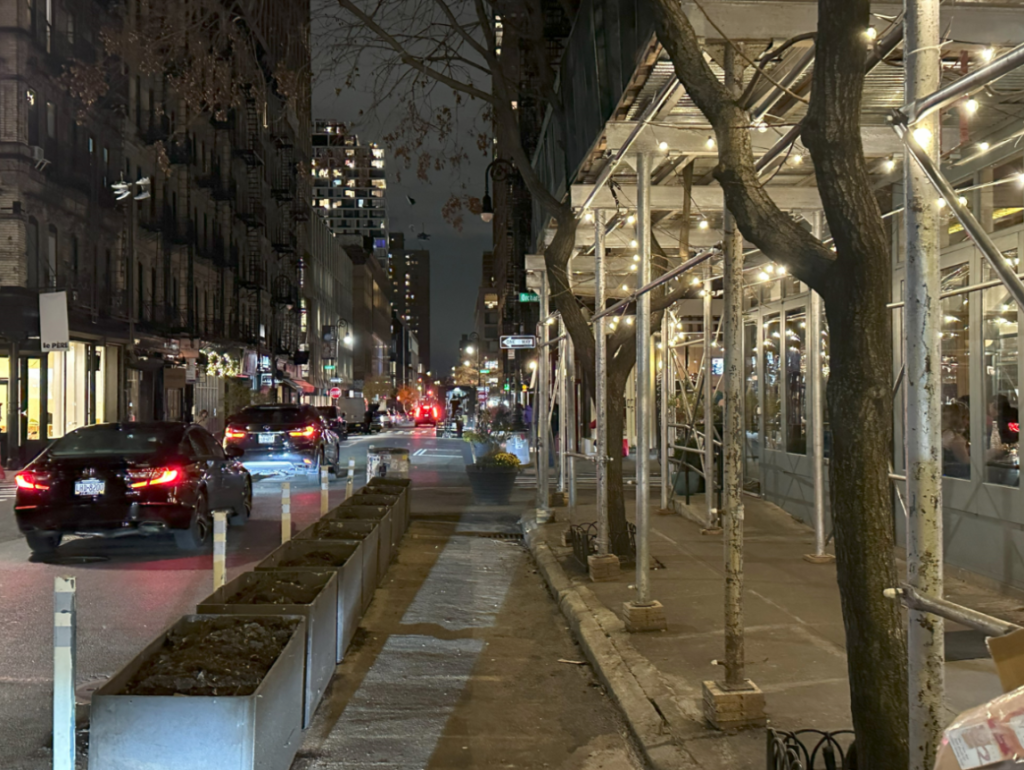
Roadway where sheds used to be. Photo: Nacha Li
Dudley’s isn’t alone in being impacted by the new outdoor dining rules.
With the city’s permanent outdoor dining program “Dining Out NYC” went into effect, all of the roadway dining sheds that have been serving New Yorkers since the pandemic are now seasonal, only allowed between April 1 and November 29, and have to be taken down during the off-season. The sidewalk cafes, though, are still permitted to operate year-round.
For someone enjoying “the seasonal stuff going on in the city,” Nicole Brennan prefers to keep the sheds. “I think it should be all the time because they could just keep changing it based on the season,” said Brennan. “As long as they take care of the cold problem or keep it warm, I think it’s nice. Like right now for holidays, too,” she added.
“One time we stayed outside in January and it wasn’t closed and literally our hands were gonna fall off,” said Jenna Brennnan next to her, who loves to eat out as much as she can in the city, as they walked into a bar across from Freeman Alley on a Tuesday evening.
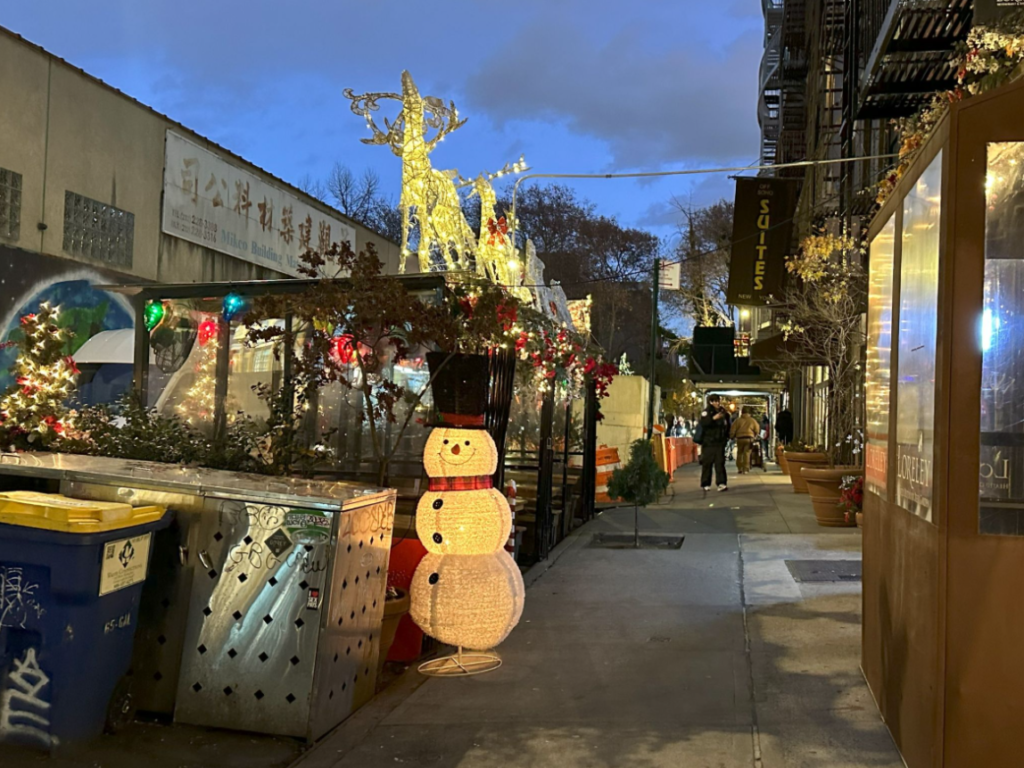
Roadway shed with holiday decorations. Photo: Nacha Li
Coldness is also a problem for restaurant workers.
“When it is a little bit in the colder months, it gets a little hard because sometimes we’ll just have one table out there tracking back in and out,” said Eliana Razin, who works as a server at the Jackdaw. “It depends on when they’ll start doing it, if it’s like December, January, February, that’s okay with me honestly, because genuinely it’s so cold. No one sits out there.”
Apart from coldness, concern about the cleanliness of outdoor dining is also one of the factors contributing to this policy shift. At Jackdaw, staff maintained their sheds on a daily basis, and locked it up at night.
“We bleach it basically every morning. That whole area every morning gets cleaned out chemically very, very aggressively,” said Razin. “I’m not sure about other restaurants, but honestly from seeing how we clean it, I would say we actually do a good job of it. At brunch when you go in there, at least in the beginning, you smell the bleach. So you know it’s killed a lot of bacteria.”
Though some saw these structures as eyesores and wanted them removed, not everyone is so confident about the effectiveness of the new measure.
“I feel like there’s already so many rats in the city. It doesn’t make a difference,” said Brette Wind outside of her East Village apartment. As a dog owner, outdoor dining sheds made it easier for Wind to bring her dog to restaurants on a night out, as non-service dogs aren’t allowed to indoor areas.
Now the new program made New York City’s outdoor dining permanent. But does permanence guarantee longevity?
“Our team is the one that is affected, and also ourselves and money are the ones who are affected mostly for taking our sections out,” said Amezaga.
With less ability to book in as many customers as before, her restaurant is making a lot less money, and had to cut the team and staff to make ends meet.
“It’s definitely gonna affect us more. Because we won’t need as many servers on the floor as well. Because we don’t need someone working out there,” said Amezaga.
Decline in jobs is also seen in other restaurants.
“I would say the cons of it are way more than the pros,” said Razin. “The one pro is just that we don’t have to go outside. That’s honestly the only pro of it going down. But the cons are less money, less hours for us or shifts.”
Serving customers during the pandemic, and having seen different phases of Jackdaw, Razin usually gets five shifts a week with her three-and-a-half-year experience at this neighborhood Irish-owned bar.
“Five shifts is good. I know I’ll make rent basically and then some, so that’s good for me,” said Razin.
With the outdoor dining sheds being taken down, restaurants face the choice of either downsizing their staff or reducing the hours of each employee.
“If we keep the same number of servers, the best we can do is probably four or three shifts for everyone, but that’s really hard to live off of,” explains Razin. “So, we’ll either have to just not hire many servers. But we can’t fire the people obviously, we’re not going to do that. So people are gonna have just less hours of making money.”
Workers taking down the sheds on West 10th Street. Video: Marcia Rock
For many restaurants, the transition to the new program doesn’t come without a cost, regardless of whether they’ll build them up again in Spring or not.
“It’s probably got to be anywhere from at least 10,000 to 20,000 just to build that, for sure, and then hiring somebody to remove it. Because not only are you gonna remove it, but you have to hire somebody to throw away the wood, the metals and all that,” said Geremi Acevedo, the general manager overseeing Sweet Chick’s Lower East Side and Flatbush locations. “Up and down probably 20,000 to 30,000 in total.”
“That’s just money that can probably be used on something else in the restaurant. There’s a million things, repairs, labor, everything costs. So I think it was better off that we don’t have it,” said Acevedo.
For most of the restaurants giving up on sheds. High cost is the most-expressed reason. “You need to have a permit now in order to have that outside. So any restaurant, if they tryna have an outside dining, you have to apply for that. So things change. Business is different,” said Acevedo.
Aside from the cost, Sweet Chick also has their own particular reason for giving up on sheds.
Serving people since around 2021, Sweet Chick’s outdoor dining sheds have introduced increasing numbers of people to this culture restaurant that’s heavily mixed in with the music industry. With famous rapper Nas as one of their biggest investors, Sweet Chick values the community they serve.
“A lot of famous artists come here a lot. From old-school rappers, new-school rappers, singers, everything,” said Acevedo.
As a “music guy,” he values the indoor dining experience a restaurant can bring to the customers. “I’m like, everybody back inside, come inside, come feel the energy, it’s good music, you can’t hear the music outside.”
His delighted voice flowed with the music in the restaurant throughout our conversation.
“What makes a restaurant? You have your idea, but what is gonna make a restaurant is the people, from who you hire, who you clientele, who you have come in,” said Acevedo. “With a restaurant, my biggest thing is this, the customer service. That’s what makes a restaurant, period. Whether you got it outside or inside.”